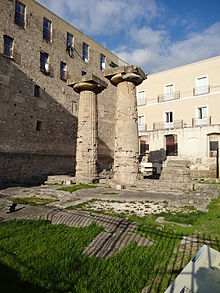Description
The devastation and ruination experienced by the temple over the centuries, especially the phenomenon of spoliation, has made it impossible to outline an exact plan of the temple.
The two remaining columns of the Doric order and three drums of a third column base were made of local carparo stone taken from the city's acropolis and were part of the long side of the peristasis of the temple, whose remains have been identified in the choir and cellars of the Monastery of San Michele, which is near the ruins alongside the Palazzo di Città [ it ]. The columns are 8.47 metres high with a diameter of 2.05 metres and are separated by an interval of 3.72 metres. From observation of the area of the peristasis and calculations of the relationship between its width and the interval, it has been suggested that the temple's front faced the navigable canal bridged by the Ponte di San Francesco di Paola, and that it had six columns on the short sides and 13 n the long sides. Further, the very low profile of the capitals and the column drums which are stacked atop one another without a central pin, indicates that they were manufactured before the beginning of the fifth century BC.
It is assumed that the Doric peristyle belongs to a phase of renovation and expansion after the construction of the cella, since there are no structural connections between its foundations and those of the older nucleus. The presence of a little ditch next to the columns, as well as traces at the edge of it, suggest the existence of a pavement and a raised wooden platform belonging to an original cult building of rough bricks and perishable material built at the end of the 8th century BC by the original Spartan colonists.
Afterlife
If still in use by the 4th-and 5th century, it would have been closed during the persecution of pagans in the late Roman Empire. The sacred area became a granary in the 6th century when the population retreated into the peninsula for defensive reasons. In the 10th century, the remains of the temple formed a Christian church, while from the 14th century, part of the area was used for industrial activity, with clay decanting vases and little kilns.
The ruins of the temple were incorporated into the Church of the Holy Trinity, the court of the Oratory of the Trinity, the Casa Mastronuzzi and the Convent of the Celestines. In 1700, ten sections of columns were still visible but they were removed and dispersed during the renovation of the convent in 1729. At the end of the 19th century, the archaeologist Luigi Viola [ it ] investigated the remains of the temple and attributed it to Poseidon, but it was more likely connected to the female divinities Artemis, Persephone or Hera. Other remains were dispersed with the demolition of the convent in 1926 and of the nearby church in 1973.
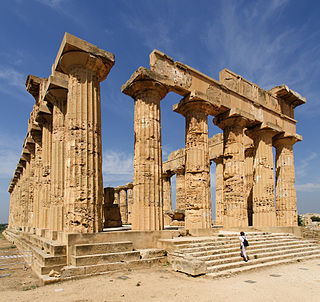
Selinunte was a rich and extensive ancient Greek city of Magna Graecia on the south-western coast of Sicily in Italy. It was situated between the valleys of the Cottone and Modione rivers. It now lies in the comune of Castelvetrano, between the frazioni of Triscina di Selinunte in the west and Marinella di Selinunte in the east.

Magna Graecia was the name given by the Romans to the coastal areas of Southern Italy in the present-day Italian regions of Calabria, Apulia, Basilicata, Campania and Sicily; these regions were extensively populated by Greek settlers. These settlers, who began arriving in the 8th century BC, brought with them their Hellenic civilization, which left a lasting imprint on Italy. They also influenced the native peoples, such as the Sicels and the Oenotrians, who became hellenized after they adopted the Greek culture as their own. The Greek colonists of Magna Graecia elaborated a civilization of the highest level, which had peculiar characteristics, due to the distance from the motherland and the influence of the indigenous peoples of southern Italy. The type of government was in the form of city-states (poleis) administered by the aristocracy. The Second Punic War put the end to the independence of the cities of Magna Graecia, which were annexed to the Roman Republic in 205 BC.

The Doric order was one of the three orders of ancient Greek and later Roman architecture; the other two canonical orders were the Ionic and the Corinthian. The Doric is most easily recognized by the simple circular capitals at the top of columns. Originating in the western Doric region of Greece, it is the earliest and, in its essence, the simplest of the orders, though still with complex details in the entablature above.

Taranto is a coastal city in Apulia, Southern Italy. It is the capital of the Province of Taranto, serving as an important commercial port as well as the main Italian naval base.

Greek temples were structures built to house deity statues within Greek sanctuaries in ancient Greek religion. The temple interiors did not serve as meeting places, since the sacrifices and rituals dedicated to the respective ouranic deity took place outside them, within the wider precinct of the sanctuary, which might be large. Temples were frequently used to store votive offerings. They are the most important and most widespread building type in Greek architecture. In the Hellenistic kingdoms of Southwest Asia and of North Africa, buildings erected to fulfill the functions of a temple often continued to follow the local traditions. Even where a Greek influence is visible, such structures are not normally considered as Greek temples. This applies, for example, to the Graeco-Parthian and Bactrian temples, or to the Ptolemaic examples, which follow Egyptian tradition. Most Greek temples were oriented astronomically.

The Forum Holitorium is an archaeological area of Rome, Italy, on the slopes of the Capitoline Hill. It was "oddly located" outside the Porta Carmentalis in the Campus Martius, crowded between the Forum Boarium and buildings located in the Circus Flaminius.

Gela is a city and comune (municipality) in the Autonomous Region of Sicily, Italy; in terms of area and population, it is the largest municipality on the southern coast of Sicily. Gela is part of the Province of Caltanissetta and is one of the few comune in Italy with a population and area that exceed those of the provincial capital.

Paestum was a major ancient Greek city on the coast of the Tyrrhenian Sea in Magna Graecia. The ruins of Paestum are famous for their three ancient Greek temples in the Doric order, dating from about 550 to 450 BC, which are in an excellent state of preservation. The city walls and amphitheatre are largely intact, and the bottom of the walls of many other structures remain, as well as paved roads. The site is open to the public, and there is a modern national museum within it, which also contains the finds from the associated Greek site of Foce del Sele.

The province of Crotone is a province in the Calabria region of southern Italy. It was formed in 1992 out of a section of the province of Catanzaro. The provincial capital is the city of Crotone. It borders the provinces of Cosenza, Catanzaro, and also the Ionian Sea. It contains the mountain Pizzuta, the National Park of the Sila, Montagnella Park, and the Giglietto Valley. Crotone was founded in 710 BCE. It participated in the Second Punic War against the Roman Republic.
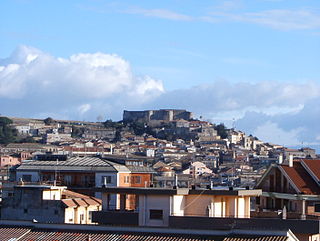
Vibo Valentia is a city and comune (municipality) in the Calabria region of Southern Italy, near the Tyrrhenian Sea. It is the capital of the province of Vibo Valentia, and is an agricultural, commercial and tourist center. There are also several large manufacturing industries, including the tuna district of Maierato. Very important for the local economy is Vibo Marina's harbour.
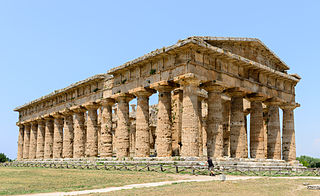
The Temple of Hera II, is a Greek temple in Paestum, Campania, Italy. It was built in the Doric order around 460–450 BC, just north of the first Hera Temple. If still in use by the 4th-and 5th century, it would have been closed during the persecution of pagans in the late Roman Empire.
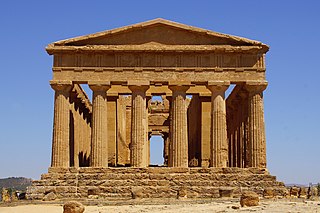
The Valle dei Templi, or Valley of the Temples, is an archaeological site in Agrigento, Sicily. It is one of the most outstanding examples of ancient Greek art and architecture of Magna Graecia, and is one of the main attractions of Sicily. The term "valley" is a misnomer, the site being located on a ridge outside the town of Agrigento.

The Temple of Hera Lacinia, or Juno Lacinia, otherwise known as Temple D, is a Greek temple of Magna Graecia in the Valle dei Templi, a section of the ancient city of Agrigentum in Sicily.
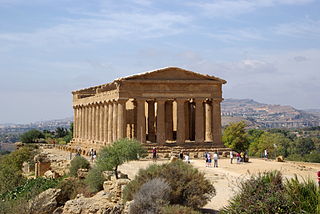
The Temple of Concordia is an ancient Greek temple of Magna Graecia in the Valle dei Templi in Agrigento on the south coast of Sicily, Italy. It is the largest and best-preserved Doric temple in Sicily and one of the best-preserved Greek temples in general, especially of the Doric order. It is located a kilometer east to the Temple of Heracles.

The Temple of Heracles or Temple of Hercules is an ancient Greek temple of Magna Graecia in the ancient city of Akragas, located in the Valle dei Templi in Agrigento, Italy.

The Temple of Apollo is one of the most important ancient Greek monuments of Magna Graecia on Ortygia, in front of the Piazza Pancali in Syracuse, Sicily, Italy.
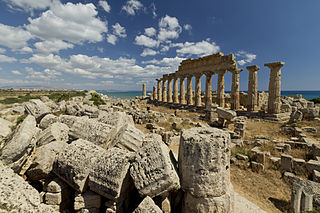
Temple C at Selinus (Sicily), is a Greek temple of Magna Graecia in the Doric style. It was one of the most ancient of the temples at Selinus, having probably been built on the acropolis a little after the middle of the sixth century BC, although its dating is controversial. The temple was the object of archaeological research in the nineteenth century and beginning of the twentieth century and later the remains of a long stretch of the northern colonnade received anastylosis in 1929. After a twelve-year-long restoration, in 2011 the colonnade was freed from scaffolding and made properly visible once more.
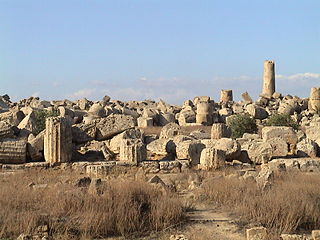
Temple F at Selinus in Sicily is a Greek temple of Magna Graecia of the Doric order. It was probably dedicated to Dionysus or Athena and is one of the three temples on the East Hill. The temple's dating is very uncertain, but it probably belongs to the middle of the sixth century BC.

The Tavole Palatine are the remains of a hexastyle peripteral Greek temple of Magna Graecia the 6th century BC, dedicated to the goddess Hera and the god Apollo. The temple, located near the Bradano river in the south of Italy, was part of a countryside sanctuary and remains of the wall of the temenos and of a very ancient altar are visible.
